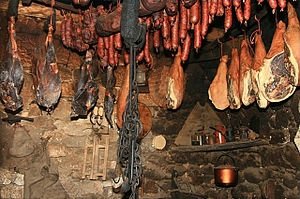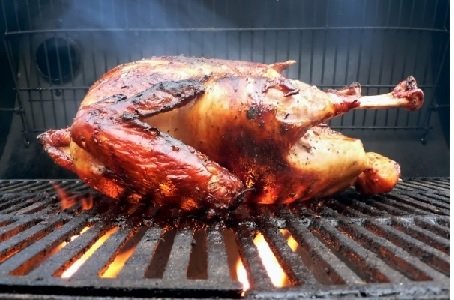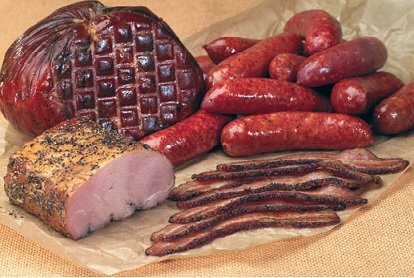The smoking process for meat, fish and cheese has been used for centuries in some countries. Its original purpose was for preservation, brought about by drying the food and introducing anti-microbiological constituents, such as a chemical called phenol, into the food from the smoke. Currently, the main purpose of smoking food is the achievement of a characteristic taste and appearance.

Today four methods of smoking are used:
• Smoking with freshly generated wood smoke (the traditional method)
• Smoking with smoke regenerated from smoke condensates
• Flavouring with smoke flavour produced from smoke condensates
• Flavouring with chemically derived smoke flavours
Traditionally-smoked food gives rise to health concerns, particularly due to the process leading to the possible production of nitrosamines and/or polycyclic aromatic hydrocarbon (PAHs). Nitrosamines are carcinogenic compounds produced by the reaction of nitrogen oxides and amines or amides (components of protein) contained in food. The risk of nitrosamine consumption is compounded by the fact that the foods that are traditionally smoked are also those highest in proteins; meat and fish. PAHs, which are also known to be carcinogenic, are formed when organic matter is burned, particularly at high temperatures. Food products smoked at high temperatures may therefore contain a high level of PAHs, predominantly on the surface. However foods smoked at lower temperatures also carry inherent risks, such as an increased risk of Listeriosis, a disease caused by a gram-positive bacterium called Listeria monocytogenes.
Smoke condensates, used as flavourings, are made by condensing smoke, which may then be further fractionated, concentrated or purified. These additional processes are employed to either enhance the smoke’s aroma, or to reduce the concentration of undesirable by-products. Smoke condensates are used to flavour food in two ways; either by being directly added to food as a liquid flavouring, or by being added to a system being used for traditional smoking,to intensify the flavour.

Smoke flavour blends are mixes of known substances in specific quantities that are added directly to food to instill a ‘smoked’ flavour. Liquid smoke (now readily available at supermarkets for home use) is produced by the destructive distillation of wood. The basic substance, pyroligneous acid, contains methanol, acetic acid, acetone, furfural and also tars and associated substances. Water, tar and acids are removed by alkali washing. The process is completed by re-acidification and the extraction of solvent.

The European Food Safety Authority is still undecided regarding the safety of these smoke flavourings. Despite there being several means available to reduce the harmful effects of the smoking process (e.g. reducing temperature or indirect smoking) and the availability of smoke flavourings that have well-known, safe compositions, traditional smoking methods are still used today. As current regulations are not strict enough to eliminate the risk of toxicity, the limitation, or even complete avoidance, of “smoked” products certainly seems one way to protect against these cancer risks.
Never new smoked food had such risk...
Everything in life requires moderation, smoked food is not left out. Interesting read
Downvoting a post can decrease pending rewards and make it less visible. Common reasons:
Submit
Smoked food offers a rich, flavorful experience that tantalizes the taste buds. The process of smoking enhances the natural flavors of meats, fish, and vegetables, creating a deliciously smoky aroma that draws in food lovers. Whether using traditional wood chips or innovative techniques, smoked dishes are perfect for gatherings and outdoor events. For those looking to elevate their culinary adventures, pairing smoked food with DMT VAPES can create an unforgettable experience. DMT VAPES add a unique twist to any meal, enhancing overall enjoyment.
Downvoting a post can decrease pending rewards and make it less visible. Common reasons:
Submit